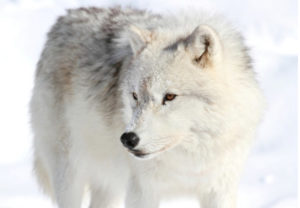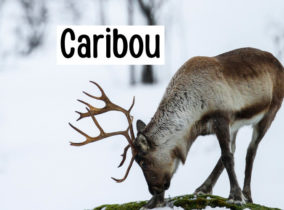| Scientific classification | |
|---|---|
| Kingdom: | Animalia |
| Phylum: | Chordata |
| Class: | Mammalia |
| Order: | Carnivora |
| Family: | Canidae |
| Genus: | Canis |
| Scientific Name | Canus Lupus Arcticus |
Habitat of the Arctic Wolf
The Arctic wolf is also known as the white wolf or polar wolf and lives in the arctic regions of North America and Greenland. Since they live in these arctic regions year round and these regions have regions have long dark periods that last about 5 months, these wolves have adapted to living in the dark and in the cold. Instead of living in dens in the ground, Arctic wolves live in caves or seek shelter in outcroppings of rocks. The ground in these Arctic areas is always frozen making it impossible for them to dig traditional dens.

General Appearance and Behavior
An adult Arctic wolf can weigh between 70 and 125 pounds. A 70-pound wolf is equal to the weight of 4 adult Dachshunds. They range between 2 to 3 feet tall and can be up to 5 feet long including their tail. Think of the average Christmas tree. An Arctic wolf’s body is about three quarters as long as that tree.
The white or sometimes grayish coat of this wolf has two layers. The upper layer gets thicker as the temperature drops in the tundra. The layer of fur closest to the wolf’s skin is waterproof. The waterproof layer of fur helps this wolf to stay dry and maintain its body heat in subzero temperatures.
Along with their insulated fur coats, Arctic wolves have paws with thick pads allowing them to walk on frozen ground. Plus, these pads give them traction on the slippery surfaces they walk and run on. Arctic wolves run while hunting muskoxen or other prey. The fastest recorded speed of an Arctic wolf is 46 mph.
You may think of a wolf as a solitary animal, but Arctic wolves travel in packs of six or so. These wolves live in incredibly cold climates, so they rarely encounter people. Normally, people don’t want to travel to these cold places! They are not aggressive animals unless they are defending their territory from a wolf or another animal.

Diet
What do Arctic wolves eat? Arctic wolves eat Arctic hares, caribou, lemmings and muskoxen. An Arctic wolf is smaller than its close relative, the gray wolf. So, you may be wondering how a single Arctic wolf could hunt and kill large mammals. The answer is: They don’t hunt alone. A pack of wolves will work together to single out a weak member of a herd of caribou or muskoxen to capture. A large mammal will be eaten by a pack of wolves over the course of a week or so. An Arctic wolf is able to eat about 20 pounds of animal meat in one feeding period. Next time you go to the store, look in the meat department and see just what 20 pounds of meat actually looks and feels like!
Reproduction and Lifespan
In a pack of Arctic wolves, only the alpha of the pack will mate with the beta female. Arctic wolves are known to stay with one mate. This helps to control the number of wolf pups also called whelps, so there will be adequate food available to them. The gestation period is 63 days and the mother gives live birth to 2 to 3 wolf pups. Newborn pups have dark fur and blue irises that change to yellow as they grow older. They weigh about 3 to 4 pounds when they’re born, but quickly start to gain more. Arctic wolves give birth later on in the month of May and sometimes early June. This is different from gray wolves. Gray wolves give birth in the month of April and usually have 4 to 5 pups in a litter.
They are born with their eyes and ears closed, but are able to see and hear within about 12 to 14 days. The pups can crawl around a bit especially when they want to nurse from their mother. In a few weeks, the pups start to nibble on small pieces of chewed food brought to them by their mother.
Arctic wolf pups stay in the cave or den with their mother for about 6 weeks. After 6 weeks, they join in the activities with the pack and are full-grown adults by 8 months. Generally, grown pups stay with the same pack for years.
The average lifespan of male and female Arctic wolves is about 7 years in the wild and 20 years in captivity. One of the most common reasons for the early death of an Arctic wolf is a lack of available food in the harsh climate. There may be a limited amount of food and that’s taken by the alpha male and beta females in a pack. Another reason for early death is injury. Arctic wolves can be injured during hunts or from another wolf or the main predator, the polar bear.
Population
The population of Arctic wolves is about 200,000. They are not considered to be a threatened species and are officially listed as Least Concern. The main reason that Arctic wolves aren’t threatened is they live on the frozen tundra where very few humans travel and where very few other animals can survive. One of the largest populations of these wolves is found in northern Alaska.
My Teaching Library Arctic Wolf Notebooking Pages
Help your students create a beautiful report using the available: Arctic Wolf | Notebooking Pages! Students will love using these pages to create a report on the Arctic wolf. They are also perfect to use during a study of the arctic region, tundra animals or as a cross-curricular unit that will have students reading, writing, completing map work (geography) and learning about the life of this cute little squirrel (science).
________________________
>> Learn more about My Teaching Library! <<






